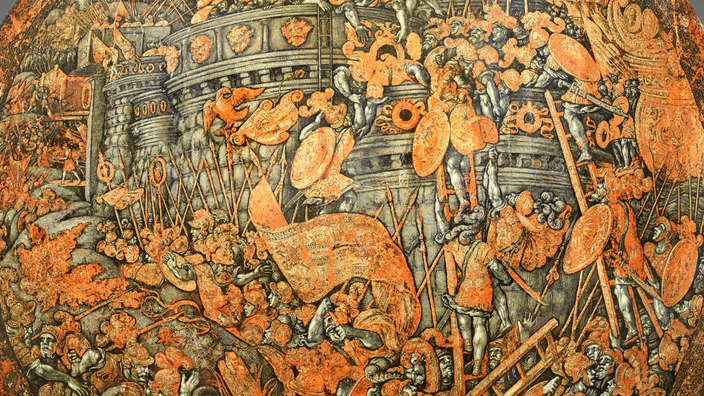A mess of ladders, shields galore, spear forests and swirling banners in the hustle and bustle of a great battle. In the midst of this throng of men and breastplates, an eagle indicates the direction of the assault to the supercharged legionaries. The lively movement of the troops is what gives character to the capture of Cartagena painted around 1535 on a tinsel ceremonial shield. Attributed to the Italian artist Girolamo da Treviso (c. 1497-1544), on a drawing by Giulio Romano (c. 1492 / 99-1546), this beautiful object from the Cinquecento dedicated to one of the most brilliant Roman victories of the Second Punic War has been, since 1976, one of the jewels of the Weapons and Armor collection of the Philadelphia Museum of Art. Plundered by the Nazis in 1943, it actually belonged to the Czech Republic, like therecently discovered the American museum. Almost 80 years after its theft, the shield will finally find the walls of its original residence.
Read alsoIn the Baltic Sea, in search of the Amber Chamber, mysterious Nazi treasure
"After eight decades, the shield will finally return home, to the site it had once occupied for years within Konopiště Castle
,
"
the Czech Minister of Culture said in a bilateral statement on Monday, Lubomír Zaorálek. The art object, about two feet in diameter - which had no real defensive use - had taken up residence in the former residence of the Austrian imperial family at the end of the 19th century. It was part of the large collection of weapons and armor installed at Konopiště Castle by Archduke Franz Ferdinand, in the midst of an impressive set of plate armor, halberds and various curiosities that still make it today 'hui the delight of tourists.
Nationalized by independent Czechoslovakia in 1919, this prestigious and coveted collection was transferred to Prague in 1943 by the Wehrmacht, with the idea of forming the nucleus of a future war museum.
But during an inventory carried out in 1946, the Italian ceremonial shield is missing, just like fourteen other objects.
Had it been stolen?
Hidden ?
Destroy ?
The trace of this “Punic shield” was actually to be found in Austria.
Stolen by the German army in 1943, the shield was formally identified this year in the collections of the Philadelphia Museum of Art.
Philadelphia Museum of Art
Moved from museum to museum
"We are pleased to announce the resolution of this investigation," said
Timothy Rub, president of the Philadelphia Museum of Art, after a joint investigation carried out in archives since 2016 by the American Art Museum and a team of Czech historians.
The shield, along with other objects transferred to Prague, had been selected from a selection of Czechoslovak treasures to supply the future permanent collection of the Führermuseum, the large art museum that the Nazi regime intended to build in Linz (Austria), with the remains of the most beautiful works taken from European collections.
Read also The Brive museum compensates the owners of a tapestry looted in 1936 in Austria
American and Czech researchers have thus discovered that the shield, supposed to be in Vienna at the end of the Second World War, ended up joining, under ill-established circumstances, the money of the American collector and patron Carl Otto Kretzschmar von Kienbusch. , who bequeathed it on his death to the Philadelphia Museum. Recently rediscovered in an archive a photograph of the shield, taken in 1913 at Konopiště Castle, has dispelled the remaining doubts about the origin of the Italian object preserved in the United States.
“Our fruitful collaboration can serve as a model of international partnership for the return of looted works of art
,
”
warmly commented Hynek Kmoníček, Ambassador of the Czech Republic to the United States.
Despite its Italian origin and its ancient subject, the conservation of the shield in the heart of Central Europe would not be the result of chance, the work having perhaps been produced for an Austrian commissioner; and not the least. According to the curators of the Philadelphia Museum of Art, the staging of the victory won by Scipio the African in the 3rd century AD could thus echo the victorious campaign led in 1535 by Charles V against the Barbary pirates. Like the Roman general before him, the Mediterranean expedition had smiled well on the emperor of the Holy Roman Empire. And could be the object of a laudatory presentation on a warlike support. Like the Roman legionaries and the Italian fleets,the warriors painted by Girolamo da Treviso will return home with their shields, victorious.

